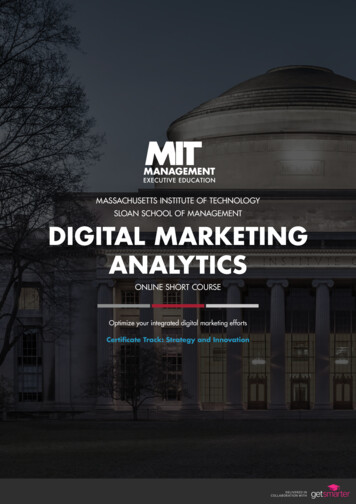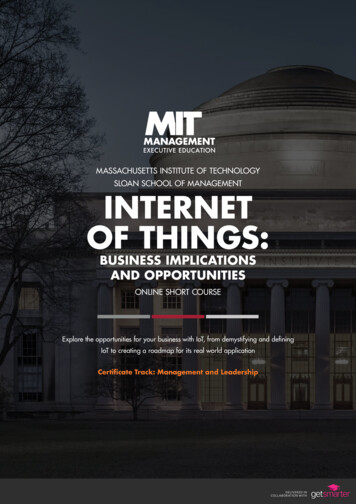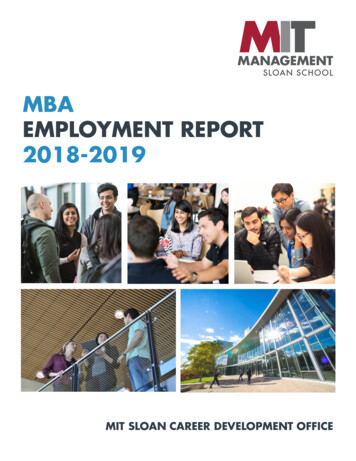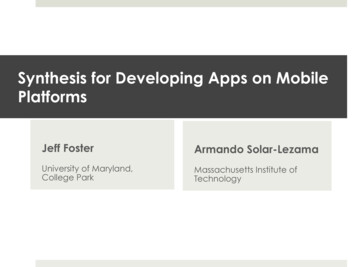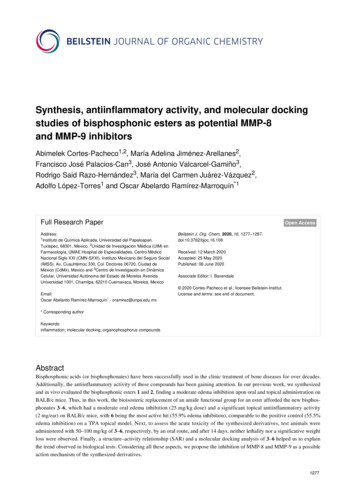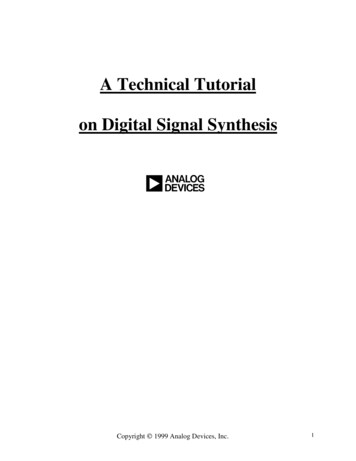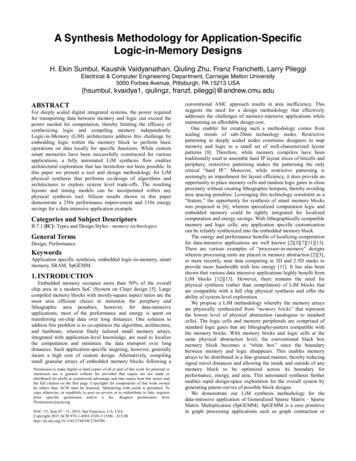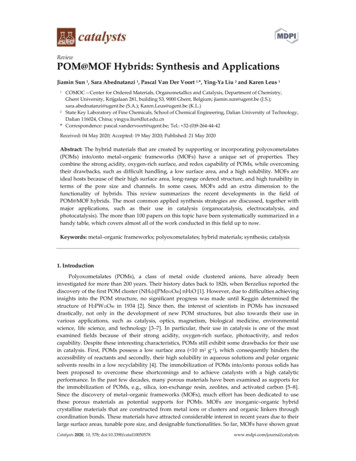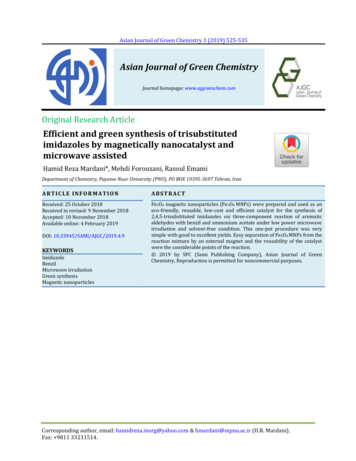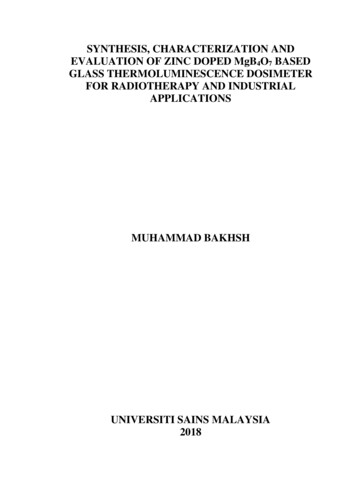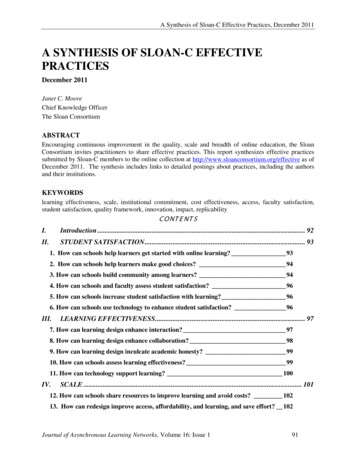
Transcription
A Synthesis of Sloan-C Effective Practices, December 2011A SYNTHESIS OF SLOAN-C EFFECTIVEPRACTICESDecember 2011Janet C. MooreChief Knowledge OfficerThe Sloan ConsortiumABSTRACTEncouraging continuous improvement in the quality, scale and breadth of online education, the SloanConsortium invites practitioners to share effective practices. This report synthesizes effective practicessubmitted by Sloan-C members to the online collection at http://www.sloanconsortium.org/effective as ofDecember 2011. The synthesis includes links to detailed postings about practices, including the authorsand their institutions.KEYWORDSlearning effectiveness, scale, institutional commitment, cost effectiveness, access, faculty satisfaction,student satisfaction, quality framework, innovation, impact, replicabilityC ONT E NT SI.Introduction . 92II.STUDENT SATISFACTION . 931. How can schools help learners get started with online learning? 932. How can schools help learners make good choices? 943. How can schools build community among learners? 944. How can schools and faculty assess student satisfaction? 965. How can schools increase student satisfaction with learning? 966. How can schools use technology to enhance student satisfaction? 96III.LEARNING EFFECTIVENESS . 977. How can learning design enhance interaction? 978. How can learning design enhance collaboration? 989. How can learning design inculcate academic honesty? 9910. How can schools assess learning effectiveness? 9911. How can technology support learning? 100IV.SCALE . 10112. How can schools share resources to improve learning and avoid costs? 10213. How can redesign improve access, affordability, and learning, and save effort? 102Journal of Asynchronous Learning Networks, Volume 16: Issue 191
A Synthesis of Sloan-C Effective Practices, December 201114. How can schools use technology to improve strategic planning? 10315. How can schools use technology to provide cost effective services for faculty, students andadministrators? 103V.ACCESS . 10416. How can specialized online student services and resources make access easier? 10417. How can schools help students access support and adapt to academic culture? 10518. How can schools provide access to special populations? 10519. How can schools use technology to improve access? 107VI.FACULTY SATISFACTION . 10820. How can schools foster greater community among faculty? 10821. How can schools prepare faculty to teach online more effectively? 10922. How can schools encourage and support research opportunities for faculty? 11023. How can schools recognize and reward faculty who teach online? 11024. How can technology help organize and enhance faculty activities? 110I.INTRODUCTIONThe Sloan-C Effective Practices collection enables educators to share practices that help make qualityonline education more affordable, accessible and effective. Sloan-C's quality framework calls for metricsto measure progress towards these goals via the five key principles that are known as pillars for achievingquality. Effective Practice postings demonstrate evidence of effectiveness in each of these pillars.Learning Effectiveness: Online learning outcomesmeet or exceed institutional, industry, and/orcommunity standards.Scale: Institutions continuously improve serviceswhile reducing cost to achieve capacity enrollment.Access: All learners who wish to learn online havethe opportunity and can achieve success.Faculty Satisfaction: Faculty achieve success withteaching online, citing appreciation and happiness.Student Satisfaction: Students are successful inlearning online and are pleased with theirexperience.As technology introduces new possibilities, theeffective practices collection is a collaborative workin progress. Educators share emerging knowledgeand advance it, and Sloan-C recognizes excellence,awarding practices that meet these criteria: Innovation: The practice is inventive or original. Replicability: The practice can be implemented in a variety of learning environments. Potential impact: The practice would advance the field if many adopted it.92Journal of Asynchronous Learning Networks, Volume 16: Issue 1
A Synthesis of Sloan-C Effective Practices, December 2011 Supporting documentation: The practice is supported with evidence of effectiveness. Scope: The practice explains its relationship with other quality elements.Practices in one area affect quality in others; thus the pillars are related and interdependent. Whenmembers post practices, they help influence the future of education. Practices are automatically eligiblefor annual Sloan-C awards. Appendix A lists effective practice awards, and Appendix B is the rubric forevaluating effective practices.This synthesis groups effective practices according to solutions that contributors have provided to somefrequently encountered questions. Hyperlinks are provided so that readers can examine details aboutpractices and the organizations and people who have generously shared them and, perhaps, develop themto the next stage of practice. Because the field is rapidly developing, the practices are called ‘effective’rather than ‘best.’ Nevertheless, acknowledging that the best is always yet to come, many of the practicesin the collection have been so widely adopted and adapted that they have become part of the lexicon foronline education.II.STUDENT SATISFACTIONSloan-C’s goal for student satisfaction is that students are successful in learning online and are typicallypleased with their experiences. Measurement of student attitudes finds that: Discussion and interaction with instructors and peers is satisfactory; Actual learning experiences match expectations; Satisfaction with services (advising, registration, access to materials) is at least as good as on thetraditional campus; Orientation for how to learn online is satisfactory; and Outcomes are useful for career, professional, and academic development [1].Student satisfaction with the entire learning experience begins with preparing learners for the onlineenvironment, continues throughout the curriculum, and continues past graduation with career services andlifelong learning. As emphasized by the Western Cooperative for Educational Telecommunications 2002report “Beyond the Administrative Core: Creating Web-Based Student Services for Online Learners,”“students expect more than static web pages—they are looking for personalized and integratedinformation and services that will support their higher education experience” [2].1. How can schools help learners get started with online learning?A full range of online services comparable to services provided on campus helps ensure that the quality oflearning is at least equivalent to learning in face-to-face settings. The Illinois Virtual College OnlineStudent Resource Center (IVC) helps students succeed in online learning with online resources for:Getting Started, Student Resources (Assessment & Testing; Diverse Populations; Financial Assistance;Health & Wellness; New Students; Purchasing Books Online; Returning Adult Students; TransferInformation); Academic Success Skills (Study Skills/Online Tutoring Sites; Library Skills/OnlineResearch Sites; Writing/Communication Skills; Survival Skills; GPA Calculator); Career & Life Planning(including tutorials that walk students through planning process); and Technology Tools (includingtutorials). Students interested in taking an online course can walk through the resources at their own pace,or they can go directly to a category of information. Students at all 66 Illinois campuses can also visit inperson any of 40 IVC Student Support Centers, one of which is located in every community collegedistrict in the state. Stark State College requires students to complete an agreement that tells them what toexpect and how to succeed. Fernuniversitat Hagen provides online tools for enhancing learningeffectiveness for easy access to personal data and calendars, assignment results, courses, and contactinformation for tutors and classmates. At the University of North Texas ecampus, a student guide meetsall five pillars of quality by providing access to course information for online students, studentsatisfaction in knowing that they are prepared for the academic and technical requirements of the onlinecourse, learning effectiveness in permitting students to get a head start on course requirements, facultyJournal of Asynchronous Learning Networks, Volume 16: Issue 193
A Synthesis of Sloan-C Effective Practices, December 2011satisfaction in knowing that their students know about course expectations, and cost effectiveness andinstitutional commitment in making course and program information available to prospective and currentstudents before they decide to enter. University of North Texas also requires beginning students to enrollin Web Institutes so that student cohorts support one another. At Saint Leo University, a required onlineorientation introduces learners to resources and expectations, with an overview of support services andresources, through an online, instructor-led orientation course that assures connection and connectivity toentry level students. At GoArmyEd (formerly eArmyU), ViCTORY (Operation Virtual CounselorTransforms Online Resources for You) is a model for soldier academic support and success; this fullyintegrated proactive student-support reaches out to soldiers in more than 50 countries. GoArmyEdcounselors regularly contact soldiers at critical points in their progress, helping to ensure a high rate ofcompletion. Similarly, mentors at Western Governors University know that learners' approaches in itscompetency-based program may range through a continuum of transforming, performing, conforming, orresisting, and so mentors establish regular contact with learners to reduce feelings of frustration andisolation. Bay Path College instituted the position of Online Student Support Coordinator; the coordinatoris the student’s initial contact with the institution, leads the orientation course, and provides ongoingsupport. Long Beach City College (LBCC) provides its orientation on learning skills, Internet skills, andcommunication skills to all LBCC faculty and students and to others who wish to use the resources atS.I.D.E. Road: Success in Distance Education. Washington State University helps students learn tocommunicate online with the help of virtual facilitators. Quinnipiac University facilitates studentachievement with self-regulated learning segments that can be linked from the course syllabus, embeddedas modules in a course, emailed to students, or accessed from a website.2. How can schools help learners make good choices?To help students project and manage their time and also to help decide which courses they can succeed in,Troy State Montgomery provides a syllabus display and time on task as part of the registration process.At Athabasca University, the detailed syllabus helps students preview expectations before taking thecourse, reduce anxiety, pace themselves, and even work ahead of schedule to accommodate business andpersonal commitments. At the University of Phoenix (UOP), personalized, student-centered life-longlearning for adult learners includes consideration for the schedules of working adults; thus, courses aretaken one at a time during a six-week-long intensive semester. UOP's small class size, academicallyqualified practitioner faculty, and outcomes oriented curricula focus on providing students withworkplace competence, teamwork practice, and improved communication skills. At Washington StateUniversity, flexible enrollment options offer students control of learning, so that they can choose to enrollin a regular semester or extend for a couple of semesters. To help establish social presence and previewsubject matter for prospective students, Washington State University provides brief RealPlayer videos inwhich the professor welcomes students with an introduction to the course. Empire State College requiresa course that becomes an educational planning environment in which students and their mentors assesstheir preparation for college; consider personal, professional, and educational goals; identify priorlearning; analyze what students need to learn; select courses; choose a concentration, make a curricularplan, and develop and articulate a degree program. At Northern Virginia Community College, a tutorialinstructional model builds learner-instructor interaction into course, assignment, submission, andfeedback processes.3. How can schools build community among learners?Because student satisfaction is rooted in a learning community, The Pennsylvania State University WorldCampus's community website connects online students to the university and builds a learning community;and its student/faculty helpdesk, an online customer service, makes online experiences more satisfying forfaculty and online students. At the State University of New York Learning Network (SLN), coursesemphasize the importance of required interactions between student and faculty, and SLN continuouslyassesses student satisfaction and reported learning, interaction, learning community formation, and more.94Journal of Asynchronous Learning Networks, Volume 16: Issue 1
A Synthesis of Sloan-C Effective Practices, December 2011To encourage its graduates to stay identified with its community, University of California Berkeley offerstuition discounts for alums for online courses.To prepare its students for their online course experience, Berkeley College has a comprehensive plan forpreparing online students, including an orientation site for its online degree students, a required onlinepreparatory course that prepares online students to understand the particulars of online learning andnavigate the course management system, an online library orientation, a special one-stop shopping centeronline degree site with messages from advisors and students services, an online tutoring site that is alwaysavailable to help students with course material and writing assistance, and ongoing faculty and technicalsupport. At Rochester Institute of Technology each online course has a customized course page withcourse information, school policies, access and equipment information, and resources. FrederickCommunity College (FCC) provides a comprehensive array of online library materials and services.Library resources available by remote access include the library catalog, reference data bases, onlinejournals and full-text resources, government documents, news services, and other sources. The libraryalso creates custom web pages with resources that are relevant to individual courses. Services providedonline include reference and research assistance, document delivery, interlibrary loan, partneringprograms with local libraries, and library user training, including research techniques.To welcome students to the course community, a professor at Charter Oak State College telephonesstudents on the first day of class to establish communication. At Mercy College, students feel morecomfortable about asking for assistance when they can ask their peers, students who are tutors,facilitators, and role models. At the University of Massachusetts Lowell, a course community andresource website builds community building through sharing of student pictures, current and past studentwork, and extensive resources. The University of Arizona College of Nursing Online PhD Programrotates student photos on its portal as an easy way for learners to match names with faces. “Well begun ishalf done” at Old Dominion University, where the online student orientation website is an interactivegateway that helps prospective students to become acquainted with distance learning. Students can assesstheir computer proficiency, learn about course registration, and choose from a variety of helpful tutorials.Faculty may refer students and advisees to the site, and it can easily be embedded into a preexistingwebsite or course site. The Orientation site not only serves as an efficient segue to distance learning, butalso proves to be an encompassing resource that can be referenced throughout distance learners’ academiccareers. Connecticut Distance Learning Consortium provides a collaboratively designed eportfolioplatform to support learning, reflections, advising, career services, and assessment. Students use theplatform to track and annotate their education, experience, and goals. They can collect samples of theirwork to create portfolios and showcase specific experiences, photos, career documents, and portfolios toinvited faculty, peers, employers, or others. A “counselor” view allows students to work virtually withadvisors and career counselors.At Saint Joseph's College of Maine, proactive academic advising for distance students meet theinstitutional goal of providing distance students with access to the same or better resources as theircampus-based counterparts. Academic advisors maintain regular contact with prospective students viaphone, mail, and email, and help students evaluate their academic and technical readiness for distancelearning. Along the way, they encourage students to consider how their pursuit of distance education willfit into their family and work lives and to solicit support from family and friends. Students help studentslearn at Mercy College where students who have excelled in online courses become “wizards,” onlineteaching assistants. In Mercy College 's Master of Organizational Behavior program cohorts build onlinelearning community as learners engage with permanent 12-month cohort of learners, with a permanentlyassigned mentor, and a permanent team of instructors; learners report a transformation in their academic,personal, and professional development; and the program boasts a 90% success rate.GradeGuru brings peer-support and collaboration to online learning with web 2.0 by enabling students toshare notes, build reputations and earn rewards. The University of Leeds uses online multimediaJournal of Asynchronous Learning Networks, Volume 16: Issue 195
A Synthesis of Sloan-C Effective Practices, December 2011resources to support students working in teams. The collaborative VoiceThread: Enhances Community,Increases Social Presence and Improves Visual Learning.4. How can schools and faculty assess student satisfaction?To make sure it provides a satisfying learning experience for graduate students, the Stevens Institute ofTechnology's WebCampus monitors student satisfaction and other responses every semester by surveyingits online graduate students to find out how eager students are to learn and to be involved with theirlearning environment, how ready they are to collaborate with other students, and how at ease they arewith their instructors. Students perceive that their learning is on a par with traditional mod
Long Beach City College (LBCC) provides its orientation on learning skills, Internet skills, and communication skills to all LBCC faculty and students and to others who wish to use the resources at S.I.D.E. Road: Success in Distance Educa
